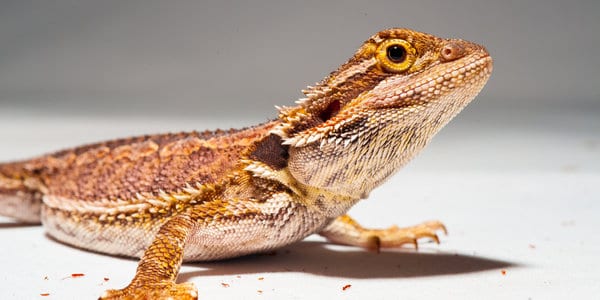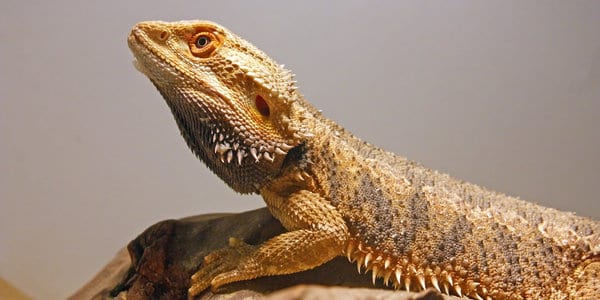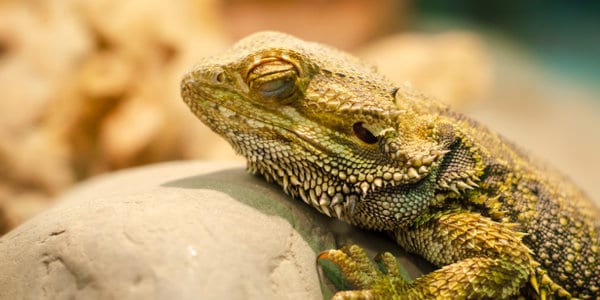Bearded dragons, or beardies, as they are often called endearingly, have become increasingly popular pets due to their relatively low maintenance natures, calm temperaments, and somewhat small size.
Even though it generally doesn’t take much to care for a bearded dragon, they can sometimes have health complications, like all animals. One of the most common problems reptile owners notice is the lack of appetite.
If your bearded dragon stops eating, it’s most likely due to improper conditions in their enclosure. Apart from that, it may be due to stress, parasites, or other diseases. In most cases, this problem can be solved by making adjustments in the vivarium. Otherwise, you should see the vet.
In this article, we’ll outline the most common causes for your dragon’s lack of appetite and the things you can do to make your bearded dragon eats again.
We’ll take a look at the proper bearded dragon husbandry, as well as some common health problems they suffer from, which might make them lose their appetite. Let’s dive right into it.
Poor Husbandry
Your beardie’s environment is going to have a crucial influence on their health and well-being. This is especially true when it comes to food.
Most, if not all, animals are going to lose their appetite if there’s something wrong with their living space, and the same goes for beardies.
Some of the most common problems that bearded dragon owners make in husbandry are:
- Improper lighting
- Improper temperature
- Improper diet
- Improper humidity
- Improper substrate
Let’s examine each of these points individually and see what you can do to change your bearded dragon environment and make it happier while increasing its appetite.

Improper Lighting
Lighting is extremely important in your dragon’s enclosure. Bearded dragons are desert animals, originally from Australia, so they require tons of lighting for optimal conditions.
If their enclosure is too dark, they are going to suffer. However, the enclosure can get too light as well, so you have to maintain a balance.
UV light is particularly important for your bearded dragon health. This includes both UVA and UVB light, but it seems that UVB light is of special importance, so you have to ensure that you’re getting them a light bulb that can produce UVB light. This stands as a replacement for natural sunlight.
UVB lighting is of great importance because it helps bearded dragons synthesize vitamin D3, which is a crucial element for their health. Light bulbs that produce UVB light can do a good job at boosting their D3 levels.
UVB lights should be on a 12–14-hour cycle during warm months, and on a ten–12-hour cycle during cold months.
The bulb should be some 12 inches (30.48 centimeters) away from your bearded dragon, and there should also be shaded places, so they can choose to hide from the light, as they would naturally do in sunlight.
Of course, if there’s access to direct sunlight, not filtered by glass, plastic, or plexiglass, you should allow your lizard to bask in it for at least 30 minutes every day.
Improper Temperature
The matter of temperature is closely related to light. Their origin in the Australian desert makes beardies accustomed to not just bright lights, but also to heat. If it’s too cold in the enclosure, your bearded dragon will lose appetite and refuse to eat.
A low temperature will make your bearded dragon digestion slow down and may cause constipation. Therefore, you have to make sure to provide the right temperature for optimal digestion and health.
Daytime temperature in the enclosure should be between 27 and 29 °C (80–85 °F), with basking spot at a temperature between 32 and 35 °C (90–95 °F). At night, the temperature should drop to around 21 °C (70 °C).
It’s also not a bad idea to provide a ventral (meaning under something) source of heat. You can use a black rock under the basking light, on which your bearded dragon can lie down and enjoy the warmth. This can also aid digestion.
A less budget-friendly option is getting a heating pad, strip, or ceramic bulb. However, an additional heating source may not be necessary at night, as dragons prefer cooler temperatures during their nap time.
Improper Diet
Bearded dragons are naturally omnivorous, which makes their food choices relatively wide. However, observations of bearded dragons in the wild show that adult bearded dragons are mostly herbivorous, with around 90% of their diet consisting of plant matter.
Juvenile dragons are truly omnivorous, with animal matter making up around 50% of their diet.
Leafy greens should be the primary thing that you include in your bearded dragon’s diet, and you should do this every day. Some prime choices are:
Opinions are divided on whether or not spinach is safe for bearded dragons. To be on the safe side, you should probably avoid it.
There are some bulk vegetables you can also offer from time to time. These include:
When you want to offer leafy greens, you should chop them up and lightly spray them with water. It’s also advisable to dust them with a calcium supplement.
When it comes to animal-based food, you can offer live insects, primarily crickets. Insects should be well-fed before and dusted with calcium and vitamin D3 supplements twice a week. Apart from crickets, you can also use:
The insects should not be bigger than the bearded dragon’s mouth. Sometimes, owners give them insects that are too big, and dragons are naturally disinclined towards them.
You can feed your baby bearded dragon insects daily. You can dust them with calcium and D3 three or four times a week, as well as with a multivitamin once a week.
The main goal should be to imitate the diet a bearded dragon would have in the wild. This means that you shouldn’t rely too much on commercial feed. Commercial feed should not make up more than 50% of the diet.
You should also avoid feeding your dragon more than once a day. Otherwise, they may become obese and refuse to eat regularly. You should weigh your dragon periodically and see if there are any changes. Your dragon’s weight should not fluctuate by more than 5%.
Improper Humidity
Humidity is another important element in emulating the natural environment of a dragon. Humidity levels should be kept between 30% and 40% for optimal health and proper digestion.
Anything above or below that might stress your lizard and cause digestive and other issues.
Improper Substrate
This aspect can be overlooked when it comes to bearded dragon not eating and digestive problems. In some cases, your dragon may swallow a large piece of the substrate in the vivarium, which can then get lodged in their intestines. These pieces are difficult to pass and may require medical attention.
To avoid this, the substrate should be sandy and fine, free of all large chunks which your dragon might accidentally swallow while eating.
This also allows digging, which is something a dragon does in the wild, and makes it feel more comfortable in the enclosure.
Now that we’ve taken a look at the steps you need to take to create the most comfortable environment for your dragon, let’s look at some other things that may make it eat less.
Stress
People sometimes see reptiles as unemotional and cold, and can therefore pay insufficient attention to their emotional needs.
In spite of this opinion, lizards, including bearded dragons, can get easily stressed out, even though we might not notice that.
Stress is caused primarily by poor husbandry, so addressing the points related to that (those outlined above) should relieve your dragon of stress.
Another key point, however, is that bearded dragons are solitary animals and can be easily stressed out by the presence of other dragons in their enclosure.
If you own multiple dragons, make sure that the enclosure is large enough. A large enclosure is particularly important if you’ve got two males in it, especially if they’re young bearded dragons.
Fighting and bullying are relatively common among bearded dragons, so putting more than one in an enclosure will be an instant risk of violence.
Another cause of stress can be handling, especially if it’s for longer periods of time. You have to keep in mind that bearded dragons are wild animals and are not used to petting like cats and dogs are.
Even if it is somewhat difficult, you’ll have to avoid petting your dragon too much. If you want a household pet you can stroke often, a dragon may not be for you.

Parasites
Just like all other lizards, bearded dragons can suffer from parasitic infections, which often lead to intestinal problems, weight loss, loose teeth, and a lack of appetite.
They can also cause changes in their droppings, so if you notice any changes in this, you should get a veterinary advice to inspect the feces under a microscope.
The most common parasites a bearded dragon can suffer from are:
- Coccidia
- Pinworms
- Flagellates
Thankfully, all of these parasites are easily treated if you act quickly and apply the proper treatment. They’re fairly common, especially pinworms, which have been found in 48.7% of dragons.
Most fecal samples examined by veterinarians were positive for some type of parasite, which means that this is a fairly common condition and not necessarily a cause for alarm.
Other Health Problems
Bearded dragons often suffer from metabolic problems such as metabolic bone disease, which are usually caused by poor diet and inadequate exposure to UV light.
These problems obviously circle back to husbandry, which means that they require your attention more (to caught early) than the vets unless they get really serious.
Lizards can also suffer from serious health problem such as cancers, tumors, and leukemia, like most other animals. These can cause a significant drop in their appetite, as well as a physical obstruction in their intestines.
These conditions, of course, require strict medical attention. Also injured bearded dragon won’t eat and may lose weight therefore its better to visit and get a veterinary advice about your beardie’s health and how to keep it healthy.
Some other common diseases in bearded dragons include:
- Constipation
- Tympany
- Meteorism
- Skin tumors
- Lymphoma
- Ganglioneuroma
Brumation
Brumation is the bearded lizard equivalent to hibernation. It usually occurs during cold winter months, when lizards burrow and rest in a dormant state for a couple of weeks, up to a couple of months.
Since this is a period of hibernation, they will naturally need less light and warmth, as well as food. During this period, bearded dragons eat very little or nothing at all, so this behavior should not worry you much.
However, their weight should not change significantly during this period. If you notice that there is a change in your pet’s weight, it means that there might be something wrong.
You should periodically check your lizard’s weight even during this period and track changes.
Some authors suggest that brumation is not necessary in captivity, but it is still advisable to replicate it to ensure that your bearded dragon is living the most natural life possible. You should try to induce brumation as winter approaches.
You can start by reducing the temperature under the basking light to around 24 to 27 °C (75 to 80 °F), while the nighttime temperature should be about 16 °C (60 °F) as bearded dragon prefer cold temperatures.
You should do this for four or six weeks to imitate the dragon’s natural environment. It will naturally start to eat less and lie dormant for long periods of time.
You should provide some artificial caves or something similar to allow it to hide. It’s also advisable to soak it in water for 20 minutes every week or two to prevent dehydration.
The Normal Behavior of a Bearded Lizard
There are a few signs that indicate that your bearded lizard is happy and in an enjoyable environment.
A normal healthy bearded dragon will be relatively active during the day, but they will still spend the bulk of their time lounging in the sun and soaking up the warmth.
In the wild, they tend to lie on fences, dead trees, and rocks, absorbing the sun, and they will do likewise in captivity if they’re in good shape.
They also need some shade occasionally, so they will sometimes withdraw under rocks or branches to avoid excessive sunlight.
Bearded dragons are also very territorial and have a hierarchy based on their size. Large males are dominant and will engage in fights with other males over mating and territory.
They will even exclude lizards of other species from their turf. That is why keep in mind that if you keep two bearded dragons together they may become aggressive tank mates.
So, if you’ve got more than one bearded dragon, don’t be surprised if they engage in fights. It is normal for their species and isn’t uncommon at all, especially if you’re housing two males in the same enclosure.
Try to avoid keeping two bearded dragons together; if you want two pets, purchase and set up two enclosures.

Final Thoughts
If your bearded dragon won’t eat, the culprit is most likely related to a problem in husbandry. Check out everything in your dragon’s enclosure to ensure it’s at its optimal settings.
Try to maintain the optimal temperature, proper lighting, humidity, and diet to ensure that their digestive health is at its peak.
You should also ensure that they’re not stressed out, so try not to hold or bother them too much.
Bearded dragons can feel stress, much like other animals, and it can influence their appetite and make bearded dragons stop eating. This lack of appetite can also be caused by various other diseases, parasites, and bacteria.